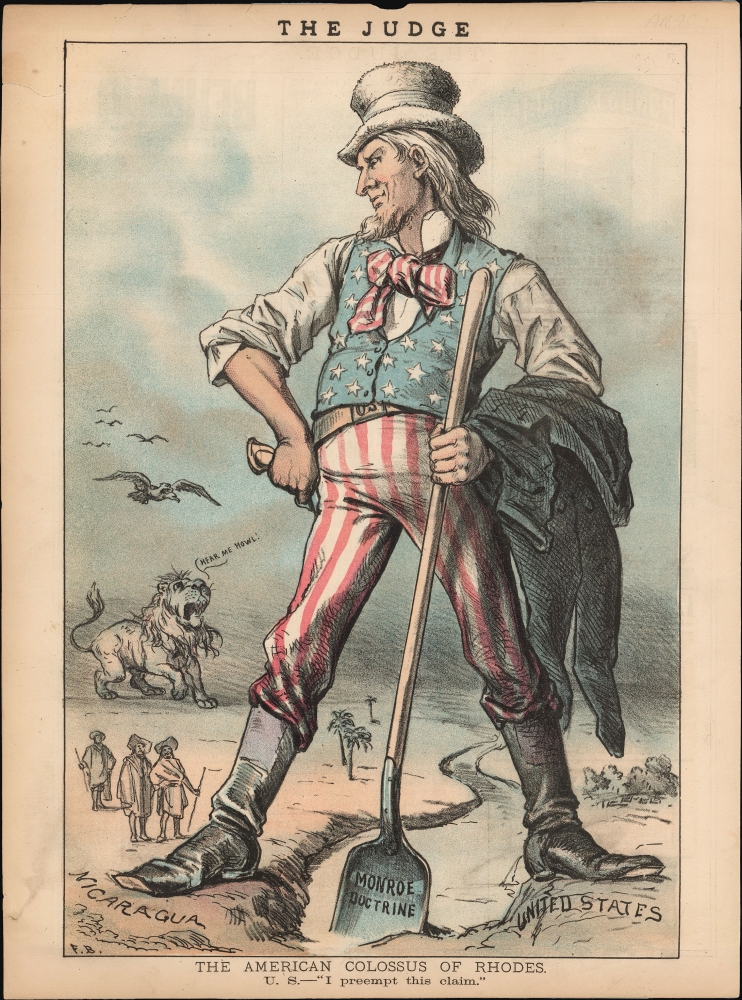This item has been sold, but you can get on the Waitlist to be notified if another example becomes available, or purchase a digital scan.
1885 Frank Beard Political Cartoon of Uncle Sam Astride the Nicaragua Canal
Colossus-beard-1885
Title
1885 (undated) 12.75 x 8.25 in (32.385 x 20.955 cm)
Description
A Closer Look
Dominating the image is a confident, cocky Uncle Sam: his jacket over an arm, his sleeves rolled up for work, and a shovel in hand. The Colossal American has one booted foot planted on the United States, the other on Nicaragua, these two are divided by water. Sam's shovel is labeled 'Monroe Doctrine'. Onlooking Nicaraguans are dwarfed by the towering figure. In the background, a feeble-looking lion, Great Britain, protests - 'Hear Me Howl!' - while vultures hover overhead. Sam is quoted below: 'I preempt this claim.'The image is reflective of The Judge's editorial position on the 1884 Frelinghausen-Zavala Treaty (also known as the Nicaragua Canal Treaty.) This agreement - signed but not yet ratified at the time of this image's publication - would have given the United States exclusive rights to build a canal across Nicaragua. This flatly ignored the 1850 Clayton-Bulwer Treaty, signed by the United States and Great Britain, which established that both countries would have equal access to any prospective canal through Nicaragua, that neither country would build such a canal without the other's consent, and that such a canal would be open to all nations. As the image suggests, the application of the Monroe Doctrine to the Nicaragua Issue would establish that a canal passing through the Americas would fall squarely within the United States' sphere of influence and that the establishment of European - and especially a British - influence on the canal would run counter to U.S. policy. Britain's lion is thus impotent and (if the vultures are anything to go by) moribund. Meanwhile, France was active in Panama building the Panama Canal.
Editorial Position
This cartoon was not the only word The Judge had on this subject. The editors first argued against the Panama Canal, citing practical arguments. Their support for the Nicaragua Route, however, took a more emotional turn:Hence the Nicaraguan project… whose very contemplation has had the effect of setting the British lion's hair on end. The canal would be an exclusively American enterprise, and England fears that it would leave her out in the cold altogether. We do not think that England's apprehension will disquiet Uncle Sam very seriously. He has his Nicaraguan treaty safe, he has pre-empted the claim, and if he feels like sinking a few hundred million dollars in a ditch in Nicaragua, he will be very apt to do it without consulting England's preferences in the matter, or those of any other country.The Judge's strongest argument, then, was that the Canal's greatest benefit to Americans is that it would upset the British.
Events as they unfolded in 1885 would prove disappointing to those who agreed with The Judge's position on the canal project. The incoming Cleveland administration did not support the Frelinghausen-Zavala Treaty due to its implication that Nicaragua and the United States would be chained by a perpetual alliance and that any Nicaraguan war would thus involve the United States. Ratification of the treaty stalled in the Senate, and President Cleveland withdrew the treaty from consideration, a move in tune with his other efforts to avoid foreign entanglements.
Publication History and Census
This cartoon was drawn by Frank Beard and published in the January 10, 1885 edition of The Judge (he also drew the cover for that issue.) We see no catalog listings for this view. The separate image is not listed in OCLC.Cartographer
Frank Beard (February 6, 1842 - September 28, 1905) was an American artist, illustrator and draughtsman. Born in Cincinnati, Ohio, he began drawing at an early age and was submitting material for publication as young as 12. In the Civil War, Leslie's and Harper's commissioned the 18 -year-old Beard to accompany the Army of the Potomac as a correspondent. After the war he originated the 'chalk talk' - a popular lecture accompanied with rapid illustration - primarily in aid of his methodist wife's temperance lectures. He was for three years the chair for aesthetics and painting at Syracuse University; at the end of this tenure, he became one of the editors for The Judge magazine. Following the 1884 election of Grover Cleveland, he shifted from political humor to education, Sunday school work, and Chautaquas. Beginning in about 1885 he illustrated The Ram's Horn, a Chicago religious weekly; by 1890 he was entirely engaged with work for that magazine. More by this mapmaker...

